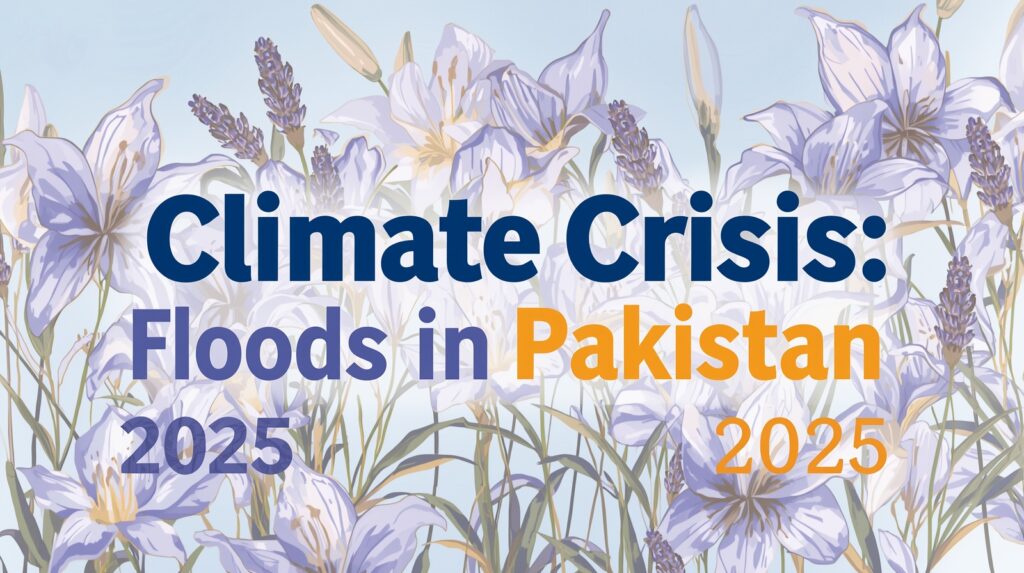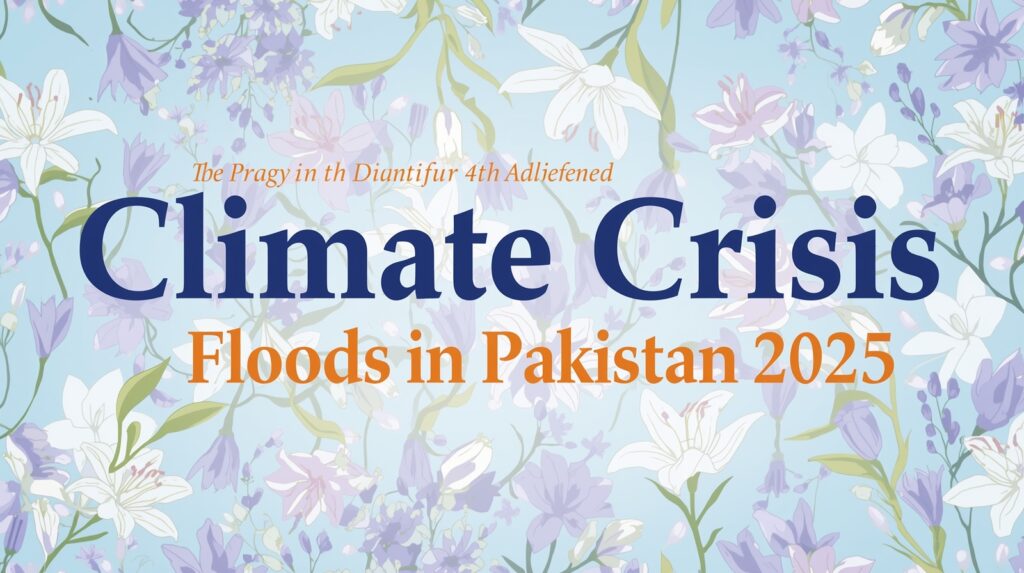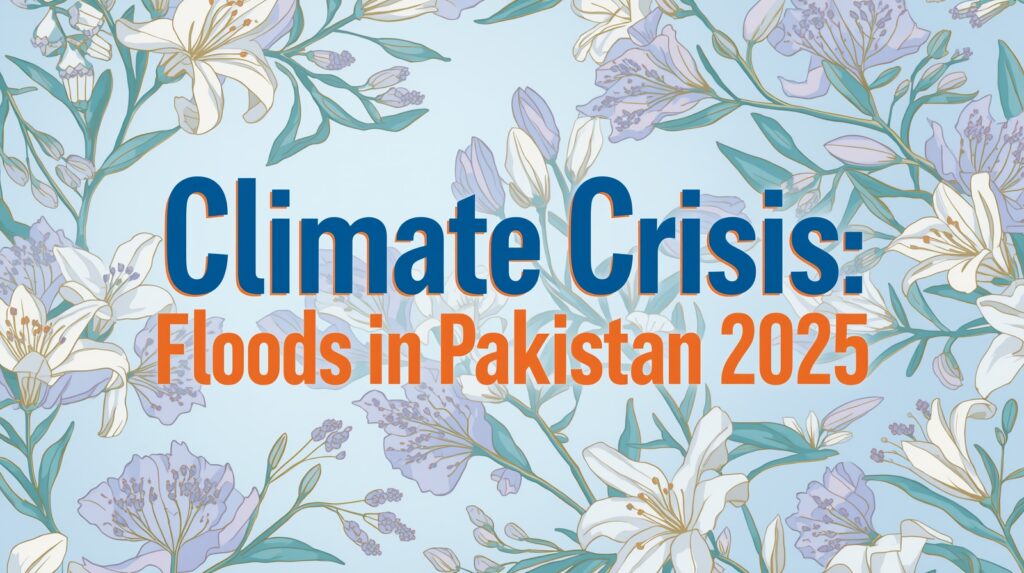- The Growing Risk of Flooding: What Causes It and What Drives It Climate Change and Stronger Monsoon Rains The monsoon season in Pakistan in 2025 has been very strong. Heavy rainfall before the monsoon season, followed by more heavy rains, have caused flash floods, rivers to overflow, and extensive flooding in several sections of the country. (Wikipedia) Climate experts say that this trend is caused by global warming, which makes weather systems change. Warmer air stores more moisture, which means that it rains more heavily in shorter amounts of time. Glacial Melt & Mountain Runoff In the northern regions—Gilgit-Baltistan and parts of Khyber Pakhtunkhwa—accelerated glacier melt has boosted river flows, occasionally generating glacial lake outbursts and flash floods. (The Guardian) As temperatures rise, the stability of glaciers diminishes, rendering mountainous places more prone to unexpected surges. Infrastructure & Basin Management Failures While climate change elevates the baseline hazard, human and institutional variables magnify the damage. Poorly maintained drainage systems, encroachment on natural floodplains, unplanned urban expansion, inadequate flood warning systems, and weak enforcement of environmental standards have compounded the impact. (Human Rights Watch) Furthermore, discharge of dam water upstream (including cross-border releases) has increased floods downstream, especially in Punjab. (Wikipedia)

The Toll: Human, Economic, and Environmental Impacts
Human Cost & Displacement
By mid-2025, the death toll had reached 1,000+ lives across Pakistan. (Wikipedia) Millions have been displaced—estimates imply 2 million+ people are living in relief camps or temporary shelters, with their homes destroyed or severely damaged. (Inside Climate News)
Health Risks & Sanitation Crises
Floods have interrupted clean water supply and sanitation systems, prompting fears of epidemics such as cholera, dysentery, and other waterborne diseases. (Al Jazeera) Displacement camps are generally overcrowded, with little access to hygienic facilities, aggravating the risks. (Al Jazeera)
Agriculture & Food Security
Punjab, frequently considered the “breadbasket” of Pakistan, has suffered badly. Over 2.2 million hectares of farmland in Punjab alone are reported to be inundated. (Wikipedia) Crops like rice, maize, cotton and vegetables have been damaged. Losses in agricultural output and changes in planting cycles will undermine food security and increase inflation of staples. ([Reuters][7])
Infrastructure, Economy & Social Disruption
Roads, bridges, schools, hospitals, and power lines have been washed away or damaged. Entire districts are cut off. Repairing and rebuilding will take vast resources. (Human Rights Watch) The economic losses may reach into billions of dollars, lowering growth prospects and laying severe weight on state budgets. ([Reuters][7])
Inequality, Vulnerability & Justice
The impoverished, underprivileged, and rural populations are feeling the brunt. Many lack means to evacuate or protect their property. In interviews, government officials have called this a “crisis of justice” – those least culpable for climate change are suffering most. ([Al Jazeera][8])
Response: What Has Been Done, What Is Lacking
Government & Institutional Actions
The National Disaster Management Authority (NDMA), provincial disaster agencies, the military, Rescue 1122 and NGOs have been active in rescue and relief activities. (Wikipedia) Evacuations, food and medical help, temporary shelters, and infrastructure repairs are occurring in several districts. (Human Rights Watch)
However, delays in warning alerts, lack of early evacuation in some localities, weak maintenance of infrastructure, and insufficient funding plague the response. (Amnesty International UK)

International Assistance & Climate Finance
International NGOs, UN agencies, and donor countries have pledged humanitarian support. But Pakistan has long contended that global climate money is extremely inadequate and inequitable—poor, climate-vulnerable countries receive a minuscule proportion of funds relative to their requirements. ([Al Jazeera][8]) Community & Local Initiatives
Local communities generally lead the first response, employing boats, rescuing neighbors, and setting up improvised shelters. Civil society groups and volunteers have filled many voids. Still, the scale of floods in 2025 overwhelms many such local initiatives. (Inside Climate News)
What Needs to Be Done: Strategies for Resilience & Adaptation
Strengthen Early Warning & Evacuation Systems
Deploy real-time hydrological monitoring, weather forecasting, automated alert systems via SMS, radio, mosques, and community networks. Local authorities must assure drills, evacuation routes, and public awareness.
Restore Natural Ecosystems & Floodplains
Preserve wetlands, woods, and river buffers that absorb floodwaters. Reclaim and enforce floodplain zones to restrict building in high-risk locations.
Infrastructure Upgrades & Climate-Smart Design
Build and retrofit levees, canals, drainage systems, floodwalls to resist extreme occurrences. Use climate-resilient designs for highways, bridges and public structures.
Integrated Water Management
Coordinate upstream dam operations, cross-border water policies, and river basin planning. Carry out assessments to forecast and mitigate cross-border water releases.
Climate Adaptation & Disaster Funding
Prioritize funding allocation for adaptation (e.g., rainwater gathering, resilient crops, drainage systems) rather than only reactive relief. Seek equitable climate finance from wealthy countries, noting that Pakistan produces <1% of global emissions yet suffers disproportionately. (Amnesty International UK)
Social Safety Nets & Insurance
Develop crop insurance, cash transfer programs, and guarantee minimal support for needy households. Build post-disaster recovery strategies to avoid populations from slipping deeper into poverty.
Stronger Governance & Accountability
Enforce environmental legislation, undertake impact assessments, make authorities accountable for urban planning and ecological blunders. Reform agencies like the Pakistan Environmental Protection Agency (Pak-EPA) and empower provincial institutions. (Amnesty International UK)

Conclusion: A Test of Will & Vision
The floods of 2025 in Pakistan are not only a natural disaster—they are a symbol of the climate emergency, of neglect, of institutional fragility, and of global unfairness. As the waters recede, the true work begins: reconstructing not just homes, but institutions that are durable, equitable, and forward-looking.
Pakistan must seize this chance to pivot from reactive disaster response toward proactive climate adaption. The lives lost, the farms drowned, and the communities displaced deserve responsibility and decisive action. If we fail, history will judge us harshly—for flooding will not remain sporadic; it will become our new normal unless we reform systems immediately.



